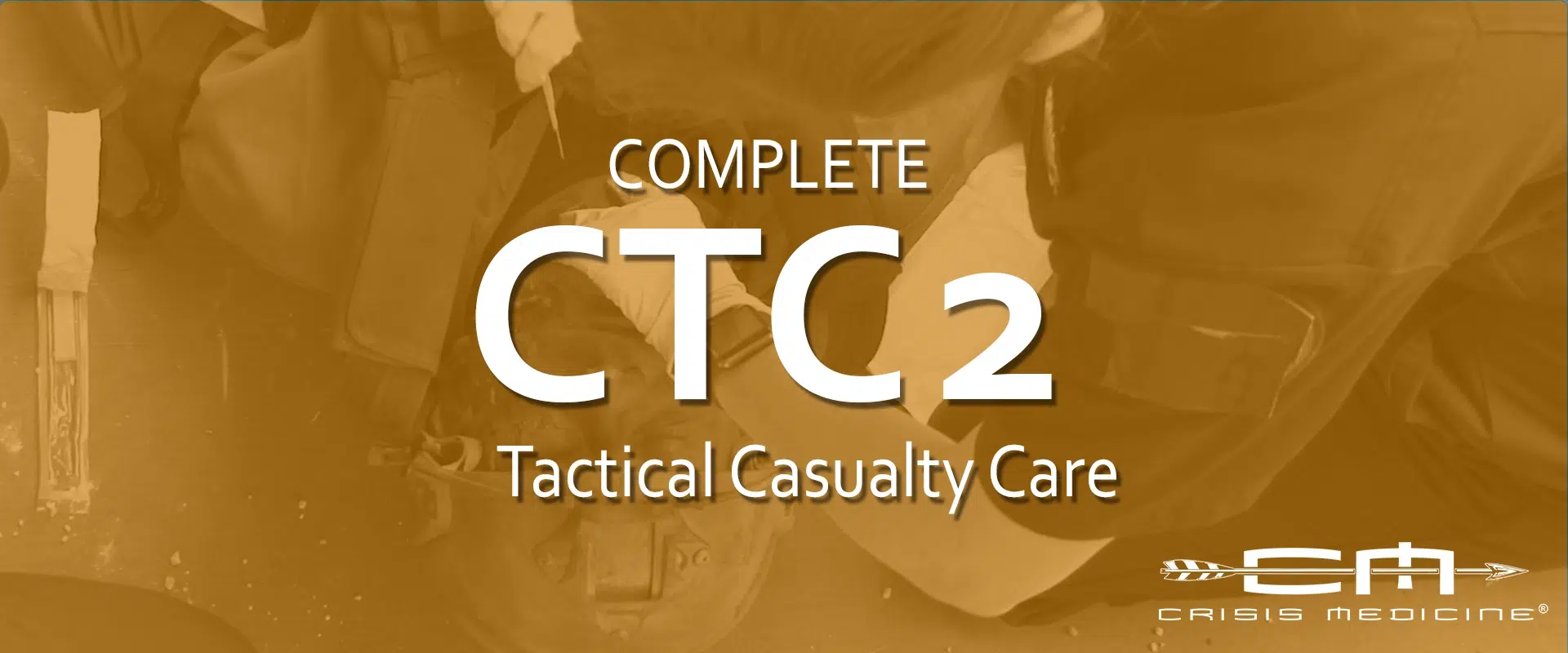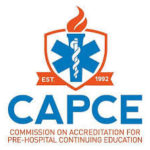Complete Tactical Casualty Care In-Person Training (5-day)

Complete Tactical Casualty Care
This dynamic and practical course covers the complete evaluation and treatment of the tactical casualty during both the Care Under Fire / Direct Threat, Tactical Field Care / Indirect Threat phases, and solid preparation of the casualty for the evacuation phase to increase survivability. This stand-alone course covers all the materials presented in the Advanced Tactical Casualty Care Course and builds upon those skills with more detailed airway interventions, surgical airways, intraosseous (and to a lesser extent intravenous) access, fluid resuscitation, TCCC / TECC relevant medications, as well as dedicated litters.
This class is consistent with current Tactical Combat Casualty Care guidelines as well as the guidelines for Tactical Emergency Casualty Care. If topics are presented in the TCCC guidelines, they’re presented in this course.
The Complete TC2 course covers everything in the Advanced TC2:
The nature and myths of gunshot wounds and realities of their medical management
How to rapidly evaluate injuries and how they affect your tactical treatment plan
The concept of “care under fire” and how it differs from a non-tactical medical situation
Choosing appropriate medical care for each treatment phase
Assessment and management of penetrating, blunt, and blast injuriesAssessment and management of massive hemorrhage including extensive practical exercises managing all types of hemorrhage, including junctional hemorrhage, effectively packing wounds, and hemostatic agents
The safe and efficient use of improvised and commercially available tourniquets
Basic airway and breathing assessment, as well as management within a high risk environment
Nasal pharyngeal airways and airway positioning
In-depth discussion of thoracic trauma (chest injuries), chest seals, recognition of tension pneumothorax and its decompression
Appropriate treatment of casualties with abdominal injuries or head injuries
Casualty hypothermia prevention
Techniques for moving casualties to a safer location, with detailed training and practice moving casualties efficiently
Triage of multiple casualties and setting up a Casualty Collection Point
Tactical casualty care concepts and their application
And the Complete TC2 Course adds the following topics and skills:
Airway management using nasal pharyngeal airways, airway positioning and surgical airways
Appropriate treatment of casualties with ocular injuries, as well as burns, fractures, and mine injuries
The reality of fluid resuscitation
Intraosseous access, and to a lesser extent intravenous access of the casualty
Using the Hypothermia Prevention and Management Kit (HPMK) and the Blizzard Bag
Proper litter use, including Skedco, Talon, non-rigid, and improvised
For the five-day course, we have extensive practical scenarios which utilize trained casualty role players, blank fire, and profuse quantities of theatrical blood. During skills stations and preliminary scenarios, students take turns role-playing a casualty, having tourniquets applied, as well as begin drug and lifted. As such, it is advisable not to wear your finest clothing. During the scenario day, students will get fake theatrical blood on them (which can lightly stain skin for a 24 hours, and can stain gear or clothing permanently).
Bring all issued tactical gear and BDU type uniforms that are acceptable to get fake blood on. This course can be physically demanding due to carrying casualties and performing simulated tactical operations so be physically prepared for this prior to course attendance.
This course was designed for the pre-hospital provider or dedicated medic in mind. Skills taught in this course include higher level, paramedic level skills and others may find some taught skills are beyond their scope of practice. Many students have attended with no prior medical knowledge or training, but the course is designed for a student with at least an Emergency Medical Responder background. This course is ideal for the tactical medic, whether in support of military operations, SOF, or tactical law enforcement operations.
Download the flyer for the class: Complete TC2 Flyer
Or consider training with us online
Note, prices are for courses taught in Portland, Oregon. Courses taught elsewhere may have additional costs for travel, gear shipping, etc. In-Person course cancellation must be made more than two weeks (14 days) before the course start date in order to obtain a refund.
| DAY ONE | ||
|---|---|---|
| 1.1 | Intro to TCCC – CTC2 | 30 minutes |
| 1.2 | Wound Ballistics – CTC2 | 90 minutes |
| 1.3 | Hemorrhage Control Concepts – CTC2 | 90 minutes |
| 1.4 | Tourniquets and CAT – CTC2 | 120 minutes |
| 1.5 | Hemostatic Agents – CTC2 | 120 minutes |
| 1.6 | Casualty Evaluation – CTC2 | 60 minutes |
| DAY TWO | ||
| 2.1 | Sensory Deprived Casualty Assesment – CTC2 | 60 minuets |
| 2.2 | Skills Review – CTC2 | 30 minuets |
| 2.3 | Thoracic Trauma – CTC2 | 60 minutes |
| 2.4 | Needle Decompression – CTC2 | 90 minutes |
| 2.5 | Abdominal Injuries and Hypothermia Prevention – CTC2 | 30 minutes |
| 2.6 | Litters – CTC2 | 30 minutes |
| 2.7 | Airway – CTC2 | 60 minutes |
| 2.8 | Cases – CTC2 | 30 minutes |
| 2.9 | Casualty Movement – CTC2 | |
| 2.10 | Casualty Movement Practical Exercise – CTC2 | 30 minutes |
| 2.11 | Head Injuries – CTC2 | 30 minutes |
| 2.12 | Skills Review – CTC2 | 30 minutes |
| DAY THREE | ||
| 3.1 | Skills Review – CTC2 | 60 minutes |
| 3.2 | Surgical Airways – CTC2 | 90 minutes |
| 3.3 | Fluid Resuscitation – CTC2 | 45 minutes |
| 3.4 | Ocular Injuries – CTC2 | 30 minutes |
| 3.5 | Intraosseous – CTC2 | 90 minutes |
| 3.6 | TCCC Concepts – CTC2 | 90 minutes |
| 3.7 | Scenarios – CTC2 | 120 minutes |
| DAY FOUR | ||
| 4.1 | Litter Practical Exercise – CTC2 | 60 minutes |
| 4.2 | Scenarios – CTC2 | 540 minutes |
| DAY FIVE | ||
| 5.1 | Scenario Review – CTC2 | 120 minutes |
| 5.2 | Fractures – CTC2 | 60 minutes |
| 5.3 | Blasts Injuries – CTC2 | 30 minutes |
| 5.4 | Burns – CTC2 | 30 minutes |
| 5.5 | Mine Injuries – CTC2 | 30 minutes |
| 5.6 | Triage – CTC2 | 30 minuets |
| 5.7 | Medical Equipment Recommendations – CTC2 | 90 minutes |
Dr. Mike Shertz is the Owner and Lead Instructor at Crisis Medicine. Dr. Shertz spent over 30 years gaining the experience and insight to create and provide his comprehensive, science-informed, training to better prepare everyday citizens, law enforcement, EMS, and the military to manage casualties and wounded in high-risk environments. Using a combination of current and historical events, Dr. Shertz’s lectures include relevant, illustrative photos, as well as hands-on demonstrations to demystify the how, why, when to use each emergency medical procedure you need to become a Force Multiplier for Good.
ALL IN-PERSON REGISTRATIONS ARE SUBJECT TO APPROVAL. YOU WILL BE NOTIFIED VIA EMAIL WHEN YOUR COURSE REGISTRATION IS CONFIRMED. IF YOU ARE NOT ADMITTED TO THE COURSE, YOU WILL RECEIVE A FULL REFUND.
For in-person courses, cancellation must be made more than two weeks (14 days) before the course start date to obtain a refund.

CAPCE Accredited Provider
This CE activity is accredited for 42.5 Advanced CEH* by Crisis Medicine, an organization accredited by the Commission on Accreditation for Prehospital Continuing
*The course runs 5-days, minus an hour for lunch. Students will be provided an online-module as pre-course work which, if completed, will be an additional 1.5 hours of CEH.
